Menus
- 129 hp at 7,750 rpm, 12.8 m / kg at 6,500 rpm, 289 kilos with full tank, € 15,899
- A big road trail with double clutch gearbox for a new way of riding
- Discovery
- In the saddle
- In the city
- On motorways and main roads
- On departmental
- All Terrain
- Part-cycle
- Brakes
- Comfort and duo
- Conclusion
129 hp at 7,750 rpm, 12.8 m / kg at 6,500 rpm, 289 kilos with full tank, € 15,899
A big road trail with double clutch gearbox for a new way of riding
Industrial success stories do not last forever. We can say, without offending them, that by launching the 1200, Honda killed the myth of the VFR. Born 750 then transformed into 800 and fitted with a V-Tec variable valve timing, this sporty roadster has won over generations of bikers with its balance, lines and character. Alas, the 1200 was losing track in a race for one-upmanship and the double-clutch gearbox, a technical and philosophical innovation in a world of conservatism, failed to seduce in this first version, despite a smooth V4 and a free power of 172 horses to which we were not entitled.
In fact, the Crosstourer, alias VFR1200X, a trail version of the VFR1200F which appeared two years later, arrived on ground strewn with negative waves. It benefits from an update for 2016 and like its road cousin, is now only offered with the DCT dual-clutch transmission.
Discovery
Some trails exude the scent of adventure or travel. Others, with their openly claimed athletic ability, want to seduce former trackers and henchmen suffering from their old arthritic bodies. They are rare, finally, the trails which claim no other objectives than the road: the Crosstourer, the old as the new, are among them. It thus finds on its way one of the six versions of the Triumph Tiger Explorer, the XR 1200, even the Kawasaki Versys 1000.
In addition to the general proportions, the Crosstourer claims belonging to the trail genre by its spoked wheels (whose mounting is crossed, which allows tubeless tires), its hollowed saddle and its generous luggage rack, its cleft lip fairing and his hand protectors. Although its size remains quite large, it does not have a protruding fairing to support its travel desires..
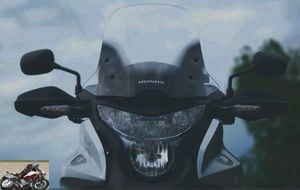
The 2016 vintage is not only Euro 4, which gives access to free power, located at 129 hp. It also has some improvements, such as the refined DCT system, an adjustable screen (the old one was particularly fishing for a glaring lack of protection), improved traction control, as well as the appearance of a 12 V socket on the control panel. edge, in the inner bulge of the fairing, left side. The colors are also new and in all cases are sober (gray, black, or black / red).
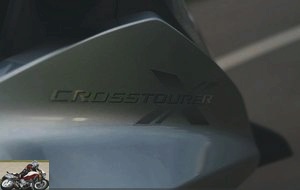
In the saddle
Perched at an altitude of 850mm, the saddle already operates a kind of natural selection. Especially since the handlebars are high and the tank wide: one can imagine that the maneuvers will require a little skill and physical strength. And this, even without having taken a look at the technical sheet: Honda announces 287 kilos fully loaded, which makes the Crosstourer the heaviest trail on the market. To his credit: the only one to also have a 1237 cm3 V4 equipped with a double clutch gearbox and a cardan shaft, which inevitably adds weight; albeit with its 258 kilograms dry, the Triumph Tiger Explorer plays in the same court, with the disadvantage of a 3 cylinder with a high center of gravity. In short, the decor is set: like many big trails, the Crosstourer is not really intended for puny and short on legs..
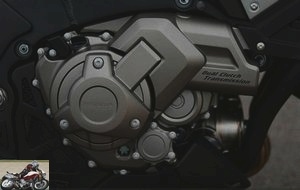
That said, provided you have the skills required, Honda still makes it easier for you with a seat that is slimmer at the level of the tank, the latter having the good taste of not being prominent. Thus, the Crosstourer turns out to be rather less intimidating than the Triumph Tiger Explorer or the Yamaha XTZ 1200 Super Tenere. The protrusion of the DCT on the right side of the engine does not interfere with the ergonomics in the saddle, where you can enjoy a straight and natural riding position.
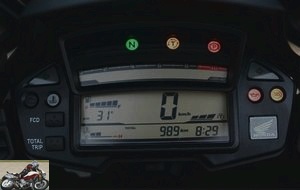
Once in the saddle, the novice can be confused. Not necessarily by the fully digital dashboard, which presents most of the information in the absence of an easily readable tachometer and a control on the handlebars of the various data, but by a little "je ne sais quoi" that changes all. Eh yes : you lack only one lever and everything is depopulated ! There is no gear selector on the Crosstourer, no more clutch lever. A button on the right stalk allows you to switch from neutral to "drive", as on an automatic car, then to "sport". On the left, well-arranged buttons allow you to manually up or down gears by pushing "+" or "-". Welcome to modernity! Before leaving, do not forget to release the handbrake, which takes the form of a large trigger located near the left stalk.
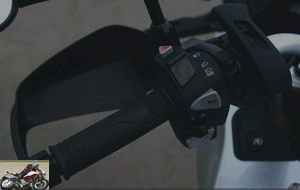
In the city
Start-up. Action! Do you know how to drive a scooter? It’s the same as the Crosstourer: speed up, the machine does the rest. So, we move forward, we get into the city traffic and with one press on the indicators, we change lanes. Tuuut! In front, a motorist surprised by this untimely blast of the horn has a brutal reaction. Sorry, old man ….
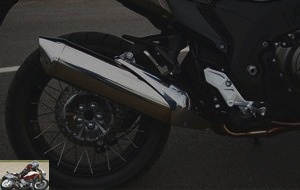
It must be said that at Honda, we once had a great idea: to disrupt 30 years of biker automation by modifying the shape of the controls and placing the horn above the indicators. A stroke of genius, while even BMW, whose system made them roar with laughter in the conventions of ergonomists (the Teutons indeed had three different commands for, in the end, a single mission), had ended up falling into line with its latest generations of machines, Honda has decided to shake it all up. As a result, you honk more than you blink and even the lighthouse call is messed up. To see again, therefore.
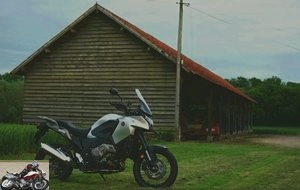
This does not prevent the big trail from scootering on the boulevards. So we praise the natural balance of this heavy machine and Honda’s decidedly impressive ability to shed pounds once in action. The narrow tires of this big machine (110 at the front, 150 at the rear), give it an ability to play in city traffic with surprising ease. Coupled braking is easy to control and the big trail shows excellent self-balance at low speed. A good surprise in the City, so.
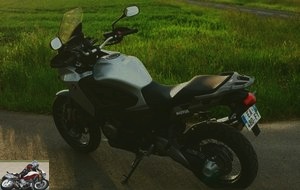
At low speed, in Drive mode, the DCT is characterized by management that makes it upshift a maximum of gears in a minimum of time, which means that you can end up in sixth at 60 km / h. This is not alarming, as the roundness and full availability of the V4 allow for smooth re-acceleration and the gearbox itself downshifts under heavier load. Note, however, that despite the improvements in its management, the DCT still slams quite pronounced on the first three reports, when we go slowly on the throttle. It is a more aesthetic disturbance than anything else. Because philosophically, being able to never touch the clutch again, ride smoothly or unload on demand, that’s a new way of experiencing motorcycles. And that’s nothing bad about it. We will also be careful when departing on the main boulevards: this big trail in the manner of a large scooter still has 129 horsepower and 12.8 m / kg of torque: speeding is very quickly guaranteed if the we do not look at its speedometer, because the roundness of the V4 and its availability from the lowest revs guarantee you to always go first at the green light and to find yourself at 70 or 80 km / h a few tens of meters further ….

On motorways and main roads
Can an automatic motorcycle guarantee fun on the main roads? Affirmative, my colonel! Because on the highway, the V4 purrs at 4000 rpm in sixth gear, which is to say that it delivers just half of its potential. With the screen in the low position, the Crosstourer provides moderate protection and turbulence increases with speed, although it is a bit better than the 2012 vintage. A plastic lever allows the screen to move into the high position, even while riding. We then gain 10 centimeters, which is not enough to completely isolate the turbulence (the shoulders remain fairly exposed), but the narrowness of the bubble still makes it possible to protect the helmet, without completely eliminating the eddies of water in the event of heavy rain. , for example.
At 4000 rpm in the torque, the Crosstourer is definitely made to swallow kilometers effortlessly; on the motorway, we saw fuel consumption in the order of 6 l / 100, which leaves almost 350 km of range thanks to the 21-liter tank. In highway cruising, Drive mode is more than enough to overtake without asking any questions. On a network more national with two lanes, more sinuous, with relief, as one could sometimes meet some in the Belgian Ardennes during this test, pressing the button "D" allows to switch to "S" then, by pressing a little longer, to select one of the three modes S1, S2 or S3. We then recover a little more dynamism, with the reports which pass a little higher in the turns (the S3 is the most radical, it leaves the 5th at 90 km / h, for example and does not enter the 6 at this speed. ) and a gearbox that is more responsive to demands on the grip and driving style. Note that the passage of the 3 upper gears is much smoother than the first three, with sometimes an imperceptible passage from fifth to sixth.
Our German friends will be delighted to learn that it takes 230 meters! Note that the Crosstourer never poses a problem of stability but that its overall comfort, a little firm without being bad, does not reach the softness of a BMW R 1200 GS and remains a little below that of a Triumph tiger explorer.
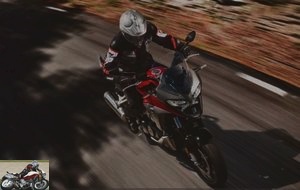
On departmental
We touched on the subject: the electronic management of the DCT gearbox has an incredible ability to quickly adapt to your driving style. Drift on a trickle of gas and she’ll go through gears as quickly as possible. Open the handle a little more and it will rev up in relation to it. However, it is possible to refine its management by selecting the right mode: between D, S1, S2 and S3, the differences are noticeable and it is in any case possible to shift gears by hand.
As the miles went by, I found the D a little too placid to be fully satisfactory. Let’s say that under normal and somewhat dynamic use, the S1 and S2 modes do well. And for more engaged driving, we can choose the S3; I also found that when attacking, the S3 allows the system to go up gears when accelerating, while when braking, I choose to lower the gears by pressing the trigger in order to manage my engine brake optimally. But the bottom line is that the Crosstourer leaves a choice.
On the secondary network, where we also observed a consumption of around 6 l / 100, the Crosstourer once again takes advantage of its relatively modest tire dimensions. Agility remains a hallmark and makes you forget the weight altogether. While not made for heavy attack, it allows for quick and effortless rewinding, in complete safety, even in a deluge and in difficult conditions. There they are, the trail roots.
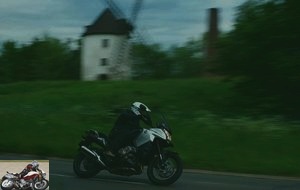
All Terrain
That’s not really its vocation (especially since the arrival of the Africa Twin in Honda’s catalog), but the 19-inch front wheel allows you to go over stony roads without breaking a sweat. The upright riding position is rather natural, but in the absence of dedicated mapping, the generously available power and torque is not always easy to manage and traction control often lights up in the dashboard. Those in a playful mood will be able to lower it a notch or two, or even deactivate it altogether, at the risk of having to regain awareness of the heavy weight of the whole in the event of a delicate situation ….
Part-cycle
Solid and proven: a large 43mm diameter inverted fork with 165mm of travel and front preload and rebound settings. At the rear, the attractive single-sided arm is connected to a single-shock absorber which is also adjustable in preload and rebound. The Crosstourer has not succumbed to the latest marketing innovations in electronically adjustable suspensions, which can be found at Aprilia, BMW, Ducati, Triumph and Yamaha. !
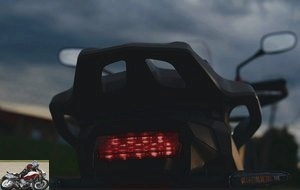
Brakes
The device is generously sized with a 276mm diameter disc at the rear and two 310mm discs at the front. Special feature: they are all clamped by three-piston calipers. Our quick-witted readers will have guessed that when there are three pistons, it is usually a sign of coupled braking! The ABS-CBS thus gives complete satisfaction, both in power, feeling and dosage. The icing on the cake: rather contained mass transfers for a trail.
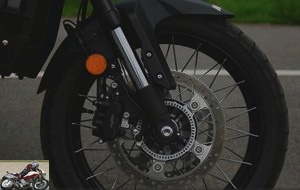
Comfort and duo
The Crosstourer is quite comfortable without being a pullman. Understand that the long stages on its handlebars can be considered serenely, but that it is however softer in the category. The suspensions (and mainly the fork) remain a little dry on small irregularities and the saddle ends up being felt after a few hundred kilometers. The passenger, on the other hand, is rather well installed, with reasonably unfolded legs and easy-to-grip grab handles.
Let us not forget either that in the context of tourist use, the DCT box also contributes to comfort through the peace of mind it brings.
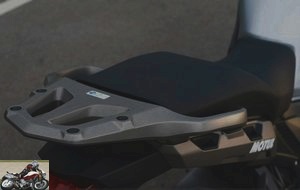
Conclusion
The Crosstourer is definitely a somewhat cerebral machine for the rider who has asked the right questions about his needs and desires. Among its deficits, its image remains fairly neutral: it does not sell dreams or escape and in this area is subject to internal competition from the Africa Twin.
His arguments are definitely in the breath of his V4 (accompanied by a fairly deep sound that suits him well) and its DCT box which infuses a new philosophy of the road, by its ability to wander the mind (and the left hand) free, or to roll up faster than expected, without forcing too much. The DCT is certainly the future, without going into the realm of perfection: if finer management than in the past does the job in 98% of cases, there are still a few situations where you can regain control of the machine in a difficult situation. absolute degree of precision (such as hairpin bends and sloping bends, grated roundabouts, etc.) thanks to joint action on the clutch and the rear brake allows you to feel in total control; this, the DCT does not allow (yet?). However, in the other cases, it sticks perfectly to the philosophy of this machine designed to swallow the kilometers in a remarkable efficiency, without fuss..
The Crosstourer is definitely a rather unique big trail in the motorcycling landscape. To try, if only to get an idea…. and take the risk of falling under its spell.
Strong points
-
A flying carpet on the road !
-
Approval, power, torque and roundness of the V4
-
To try the DCT is to adopt it !
-
Efficient coupled braking
-
Agility and maneuverability (especially considering the weight)
Weak points
-
No heated grips as standard (this should be mandatory on road-oriented machines)
-
Slamming transmission on the first 3 gears
-
Stopping and maneuvering weight
-
Fork a little firm
-
Ergonomics of the commodos
Datasheet
Test conditions
- Itinerary: 700 km on small and varied roads to the Belgian Ardennes and a few days in Paris
- Motorcycle mileage: 900 km
- Problem encountered: only water, only water !
The competition: Aprilia 1200 Caponord, BMW R 1200 GS, Ducati Multistrada, Kawasaki 1000 Versys, Triumph Tiger Explorer XR, Yamaha XTZ 1200 Super Tenere
Related articles
-
The migratory meaning The spirit of adventure certainly blows through the 2012 motorcycle production. Indeed, no less than three new maxi-trails come to…
-
Honda Varadero 1000 XLV motorcycle test
Maxi-Trail with a road vocation The Honda XL 1000 V Varadero, which appeared in 1998, is the heir to the famous Africa Twin … but the manufacturer has…
-
Mono 4-stroke, 250 cm3, 25 horsepower at 8,500 rpm, 22.6 Nm at 6,750 rpm, 157 kilos, € 6,199 A small TT-type trail with a cute Dakar proto look Amazing…
-
The trail for all Completely revised both in terms of aesthetics and part cycle, the new VFR800X Crossrunner asserts itself through an efficient,…
-
Honda Integra 750 maxi-scooter test
The biker scooter Apply to the motorcycle what the manufacturer was already doing for the car…. that is to say use a common base to decline several…
-
Honda SWT 600 SilverWing scooter test
Small wings 10 years after launching its vision of the big scooter, Honda is upgrading its SilverWing (silver wings). With, in particular, an aesthetic…
-
In-line twin, 471 cm3, 45 hp at 8,500 rpm, 44.6 Nm at 6,000 rpm, 190 kilos, € 6,299 A small accessible bobber intended for A2 licenses on a mechanical…
-
Honda Africa Twin test in the mud
Three levels of traction control, disconnectable ABS, DCT: useful, or not ? A life-size test at the Honda Adventure Center in Wales A real commercial…
-
Single cylinder 4-T, 25 hp at 8,500 rpm, 22.6 Nm at 6,750 Nm, 146 kilos fully loaded The Knacki Herta spirit of the motorcycle for 4999 € You have…
-
Honda renews its big roadster. Retro, sporty, or both ? 4 cylinders in line, 998 cm3, 145 hp at 10,500 rpm, 104 Nm at 8,250 rpm, 212 kilos with full…
It’s good to insist on the theft, I had 2 stolen in 1 year in Lyon, 2015 and 2016 edition. In Rhône Alpes it’s the hecatomb, a similar neighbor (2 in 1 year). I am at HD now and I still have it .. But great machine that’s undeniable!
Thank you for this feedback! And glad to see that this Crosstourer DCT is right for you! Like you, I find that this bike is little known (is it because of the bittersweet reception that has been reserved for the VFR 1200) and, like you, I am quite a fan of the DCT.

Good road
Totally agree with the writer of the essay who summed up the philosophy of this machine well. I am at a 1200 LC adventure after a 1200 (double shaft) in 2010 and an 1150 in 2000. I did not believe the salesman who offered me to try the new models at each release, telling me that for new decals I was not going to change machine Error. The progress is enormous between each model even if to the eye it is not visible. Too bad you could not have tried with the GPS it is magic and allows you to program routes with multiple waypoints, it is ideal for zigzagging on small roads while conventional GPS are made for a final destination and designate inevitably the highway. Unlike the other comments I consider the options essential. They alone give the quintessence of the machine’s possibilities. Why reduce the comfort and assistance capacities? Obviously in this case, the budget climbs and this is the only fault we can find in this bike. This livens up its second-hand market. For a budget that does not allow you to buy new, you can access a model which is not at the top of the day but which was a few years ago and it is already not bad. Reliability? 140,000 kms in two GS including two laps of Morocco with track, and just a clutch oil seal. Zero chain kit. Do your accounts …
Bike mate smashing. Be sure to take into account the reminder of the fork tube problem.
Just one point that makes me react, the most direct competitor of the old GS was the triumph explorer (it is not me who says it but all the written press).
> Mike
In view of the characteristics of the new road trails, the 2013 GS tends to shift its use towards more sport while maintaining good off-road capabilities at best..
If the Triumph generally approached the old GS, without equaling the original …, the new sticks a hell of a slap, at all levels.
very nice try
if you want the same equipment as the "multi 1200 s touring" you need more than 21,000 euros on the gs ….
> Chris,
I do not see how the GS could exceed the 20,000 euros of the Multistrada, at the same level of equipment. On the contrary, it remains cheaper.
Even the basic version of the Italian is more expensive: 16,390 Ђ.
For the GS base + Active pack (895 Ђ): 16,045 Ђ.
And cycle part level … in short, a comparison will explain everything.
yes indeed I just did the configurator at BMW and it made 19,500 euros with the same equipment as the multi (suitcases and start-up etc …)
(suitcases and start-up etc …)